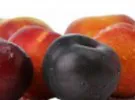Chilean stone fruit has just begun shipping to the U.S. via vessel a couple of weeks ago. “The season was seven to 10 days early this year. We started receiving early shipments in the last week of November but about four weeks ago, we started receiving fruit by vessel,” says Franco Pruzzo of Summit Produce Inc.
So far, supplies of stone fruit have been good. “It has been a little short on apricots. This week will be the last ocean arrivals,” says Pruzzo. Nectarines and peaches, both of which will ship into the U.S. until the end of March, have seen steady supplies though some smaller sizing compared to last year, especially on nectarines. Compared to last year, Summit has seen close to 40 percent more nectarines, 500 percent more plums, which it notes is a unique situation, 20 percent fewer peaches and 20 percent fewer apricots hitting the U.S. market industry-wide. Market share dynamics have also had something to do with this says Pruzzo. With fast shipping services to Asia and thus increasing demand over there, it is switching over supplies that as an industry had been very reliable and concentrated in the U.S.
Systems Approach again Meanwhile, supplies of plums are once again subject to go through the USDA-approved Systems Approach following last year’s implementation. “What we’re seeing though is not all the growers and packing sheds are certified to do this so there is a bit of a lack of supply until everyone gets certified. Yet it’s in much better shape compared to last season,” says Pruzzo. “Last year they were certified by the end of January so we lost 1/3 of the season. This year they should be better prepared and we’ll lose less than last year. Most of the growers/packers/shippers are in full swing shipping plums already.” Plums are anticipated to ship until the last week of April.
Meanwhile, supplies of plums are once again subject to go through the USDA-approved Systems Approach following last year’s implementation. “What we’re seeing though is not all the growers and packing sheds are certified to do this so there is a bit of a lack of supply until everyone gets certified. Yet it’s in much better shape compared to last season,” says Pruzzo. “Last year they were certified by the end of January so we lost 1/3 of the season. This year they should be better prepared and we’ll lose less than last year. Most of the growers/packers/shippers are in full swing shipping plums already.” Plums are anticipated to ship until the last week of April.
Demand was strong to kick the season off, particularly in the absence of domestic stone fruit. (Though South Africa is also shipping stone fruit.) However early varieties from Chile didn’t see strong taste profiles and good sizing. “So there’s good demand for bigger sizes, 48 and larger. It’s a big sluggish though on smaller sizes series 50s and 60s,” says Pruzzo.
As the volume comes on, growers and shippers are also hoping for a better logistics picture than last year. Stone fruit is a highly perishable piece of fruit and ideally shipping to the U.S. takes 17 days. Last year with the sizeable logistics issues at this time of year, it was an average of 35 days. “This was one of the categories that suffered the most with shipping delays and quick clearances,” says Pruzzo. He does note that logistics look to be improved this year though the true test will come when greater volumes of stone fruit begin shipping starting in the first week of February.
Moving to new varieties
In turn, Pruzzo would also like to see what is happening across other items, like blueberries and grapes--products that also have an active varietal renewal and ones growers are looking for higher yields from a grower standpoint as well as improved shelf life and taste profiles. “The challenge is moving away from older varieties to new ones, boosting demand and bringing similar eating experience compare to domestic crop,” he says. “U.S. consumers are used to local stone fruit which is a good quality piece of fruit that’s juicy with good flavor. There are some breeding programs in Chile being planted but growers need to move faster towards new varieties with better production.” At the same time, growers on their end need to achieve better prices/returns, 15/20 percent to compensate for the higher cost of production to make the business profitable and attractive.
As for pricing, it’s similar to last year at this time. “On stone fruit, we haven’t seen much change--it’s a mature business. For December and January, the pricing will stay where it is right now but when the volumes hit the U.S. more heavily in the first week of February, pricing will start coming down a bit,” says Pruzzo.
 For more information:
For more information:
Franco Pruzzo
Summit Produce Inc.
Tel: +1 (559) 369-4020
[email protected]
https://www.summitproduceinc.com/










